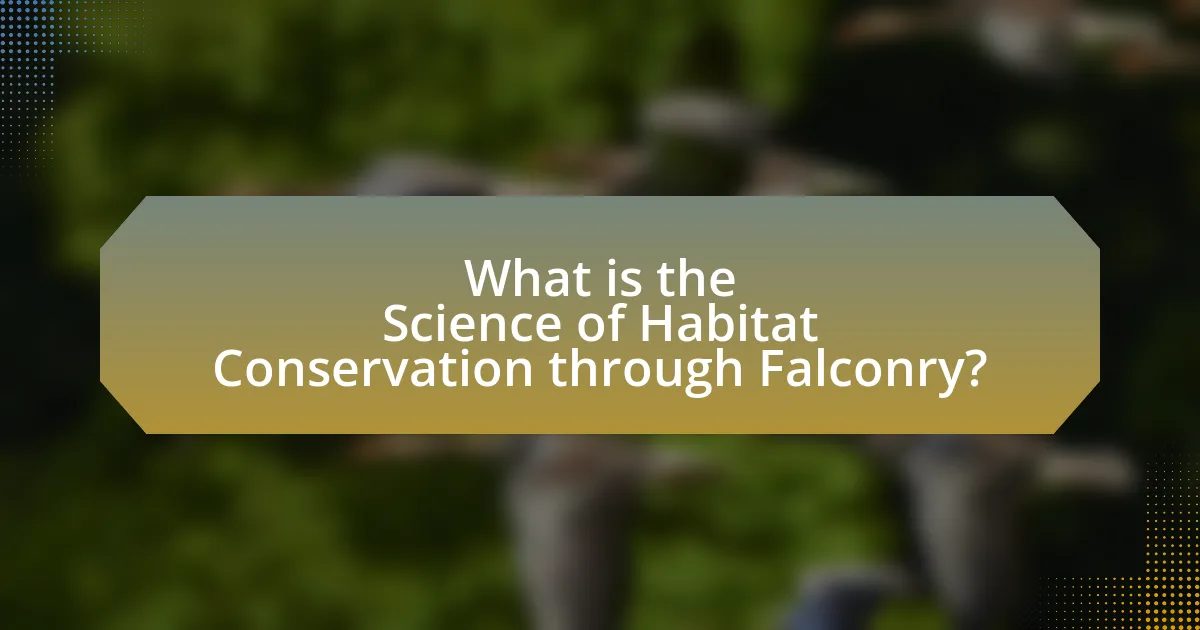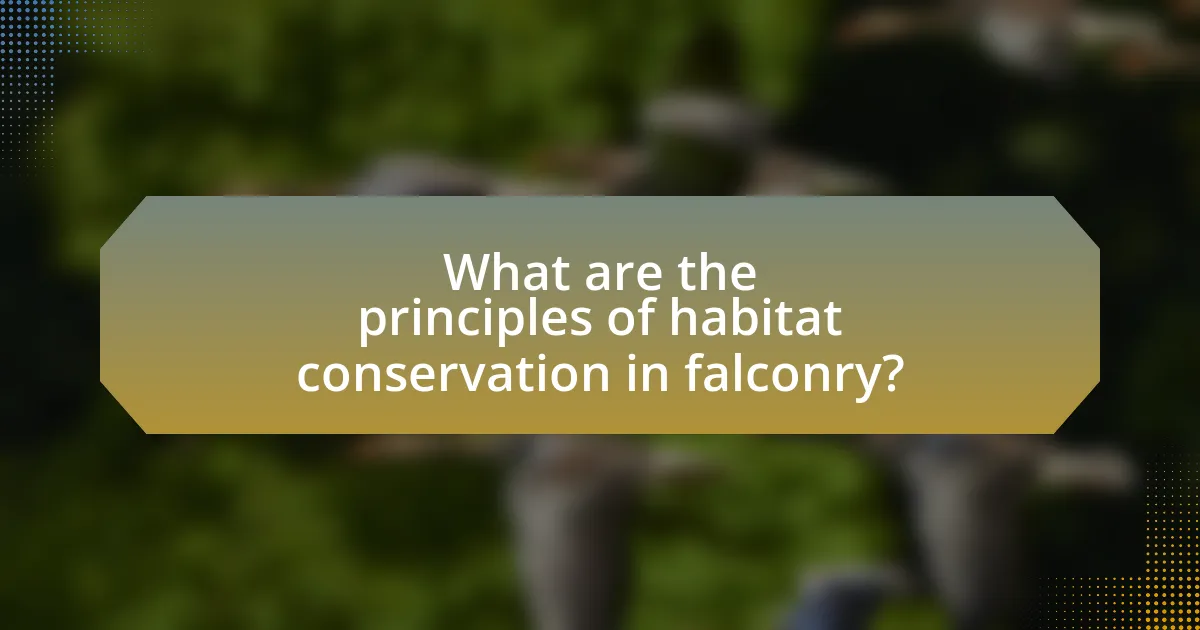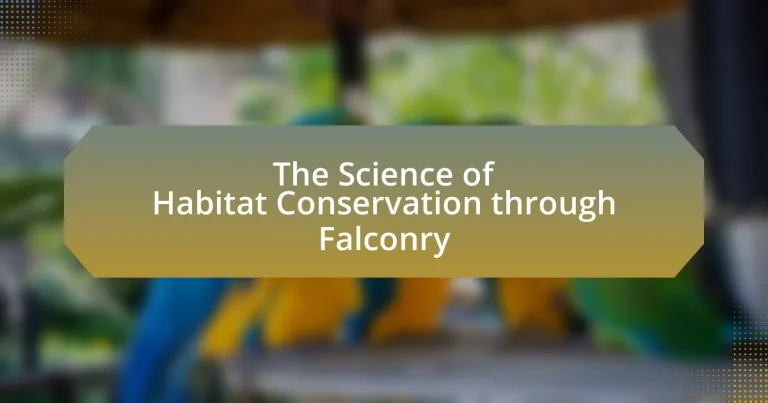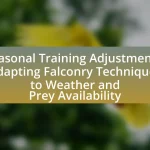The main entity of the article is the science of habitat conservation through falconry, which utilizes trained birds of prey to manage ecosystems, particularly in agricultural and urban areas. The article outlines how falconry contributes to habitat conservation by controlling pest populations, promoting biodiversity, and engaging in habitat restoration efforts. It discusses various techniques employed in falconry for conservation, the impact of raptors on local ecosystems, and the importance of habitat conservation for maintaining biodiversity. Additionally, it addresses the challenges faced by falconers, ethical considerations, and best practices for effective habitat conservation, highlighting successful case studies and the role of falconers in collaboration with conservation organizations.
What is the Science of Habitat Conservation through Falconry?

The science of habitat conservation through falconry involves the use of trained birds of prey to manage and protect ecosystems, particularly in agricultural and urban settings. This practice helps control pest populations, thereby reducing the need for chemical pesticides and promoting biodiversity. Studies have shown that falconry can enhance the health of habitats by maintaining the balance of species, as evidenced by successful programs in various regions where raptors have been employed to manage invasive species and support native wildlife.
How does falconry contribute to habitat conservation?
Falconry contributes to habitat conservation by promoting the protection of natural ecosystems and the species within them. Practitioners of falconry often engage in habitat restoration efforts, which include maintaining and enhancing the environments where raptors thrive. For example, falconers may participate in initiatives to preserve wetlands, grasslands, and forests, which are critical for the survival of various bird species. Additionally, falconry fosters a deeper appreciation for wildlife and biodiversity, leading to increased advocacy for conservation policies. Studies have shown that communities involved in falconry are more likely to support conservation efforts, as they recognize the interconnectedness of their activities with the health of local ecosystems.
What techniques are used in falconry for conservation purposes?
Techniques used in falconry for conservation purposes include breeding programs, habitat restoration, and public education initiatives. Breeding programs focus on increasing populations of endangered raptor species, such as the California condor, through captive breeding and subsequent release into the wild. Habitat restoration involves improving and maintaining natural environments to support raptor populations, ensuring they have access to adequate food and nesting sites. Public education initiatives aim to raise awareness about the importance of raptors in ecosystems and promote conservation efforts, thereby fostering community support for habitat protection. These techniques collectively contribute to the conservation of raptor species and their habitats.
How does falconry impact local ecosystems?
Falconry impacts local ecosystems by influencing prey populations and promoting biodiversity. The practice of falconry involves the hunting of wild game using trained birds of prey, which can help regulate the populations of certain species, such as rodents and small birds. This predation can prevent overpopulation, which in turn supports a balanced ecosystem. Additionally, falconry can foster conservation efforts, as practitioners often engage in habitat restoration and protection initiatives to ensure sustainable environments for their birds and prey species. Studies have shown that falconers contribute to local conservation by participating in breeding programs and habitat management, thereby enhancing ecological health.
Why is habitat conservation important?
Habitat conservation is important because it protects biodiversity and maintains ecosystem health. Healthy habitats support a variety of species, including those that are endangered or threatened, ensuring their survival and the overall balance of ecosystems. For instance, according to the World Wildlife Fund, habitat loss is a leading cause of species extinction, with approximately 1 million species at risk due to habitat degradation. By conserving habitats, we not only safeguard wildlife but also preserve essential ecosystem services such as clean air, water filtration, and climate regulation, which are vital for human well-being.
What are the main threats to habitats today?
The main threats to habitats today include habitat destruction, climate change, pollution, invasive species, and overexploitation of resources. Habitat destruction, primarily due to urbanization and agriculture, leads to significant loss of biodiversity; for instance, the World Wildlife Fund reports that 75% of Earth’s land surface has been altered by human activities. Climate change alters ecosystems and species distributions, with the Intergovernmental Panel on Climate Change noting that many species face extinction if global temperatures rise by 1.5 degrees Celsius. Pollution, including plastic waste and chemical runoff, degrades habitat quality and affects wildlife health. Invasive species disrupt local ecosystems, often outcompeting native species, as documented by the U.S. Fish and Wildlife Service. Lastly, overexploitation of natural resources, such as deforestation and overfishing, further threatens habitat integrity and biodiversity.
How does falconry address these threats?
Falconry addresses threats to wildlife and habitat conservation by promoting the sustainable management of ecosystems through the controlled use of birds of prey. This practice helps regulate prey populations, thereby maintaining ecological balance and preventing overpopulation that can lead to habitat degradation. Additionally, falconry fosters public awareness and appreciation for raptors and their habitats, encouraging conservation efforts. Studies have shown that regions with active falconry programs often see increased community involvement in habitat preservation initiatives, highlighting the role of falconry in fostering a conservation ethic among practitioners and the public.
What are the principles of habitat conservation in falconry?

The principles of habitat conservation in falconry focus on maintaining and restoring ecosystems that support raptor populations. These principles include protecting natural habitats, managing land use to minimize human impact, and promoting biodiversity to ensure a stable food supply for falcons. Effective habitat conservation also involves monitoring environmental changes and implementing sustainable practices that benefit both wildlife and human communities. Research indicates that habitat loss is a significant threat to raptor species, making conservation efforts essential for their survival and the overall health of ecosystems.
How do falconers select habitats for conservation efforts?
Falconers select habitats for conservation efforts by assessing ecological factors that support raptor populations, such as prey availability, nesting sites, and habitat diversity. They prioritize areas that provide sufficient food sources, like small mammals and birds, which are essential for the survival of falcons. Additionally, falconers evaluate the presence of suitable nesting structures, such as cliffs or large trees, that facilitate breeding. Research indicates that habitats with a mix of open spaces and cover are ideal, as they allow for hunting and protection from predators. This methodical approach ensures that conservation efforts are directed towards areas that can sustain healthy raptor populations, thereby enhancing biodiversity and ecosystem stability.
What criteria are used to evaluate habitat quality?
Criteria used to evaluate habitat quality include vegetation structure, species diversity, availability of food resources, water sources, and the presence of shelter. Vegetation structure assesses the complexity and density of plant life, which supports various wildlife. Species diversity indicates the variety of organisms present, contributing to ecosystem resilience. Availability of food resources ensures that species can thrive, while water sources are critical for survival. Lastly, the presence of shelter provides protection from predators and harsh environmental conditions. These criteria are essential for determining the overall health and sustainability of a habitat.
How does habitat selection affect bird populations?
Habitat selection significantly influences bird populations by determining the availability of resources such as food, nesting sites, and shelter. Birds that select habitats that meet their ecological needs are more likely to thrive, reproduce successfully, and maintain stable populations. For instance, studies have shown that species like the American Robin prefer habitats with a mix of open areas and trees, which provide both foraging opportunities and protection from predators. Conversely, habitat loss or degradation can lead to declines in bird populations, as seen in the case of the California Gnatcatcher, which has experienced population decreases due to urban development encroaching on its coastal sage scrub habitat. This relationship underscores the critical role of habitat selection in the conservation and management of bird species.
What role do raptors play in ecosystem management?
Raptors play a crucial role in ecosystem management by acting as top predators that help regulate prey populations. Their presence maintains the balance of various species within an ecosystem, preventing overpopulation of certain animals, which can lead to habitat degradation. For instance, studies have shown that raptors like hawks and owls can significantly control rodent populations, thereby influencing the health of vegetation and soil quality. This predatory behavior contributes to biodiversity and ecosystem stability, demonstrating the importance of raptors in maintaining ecological balance.
How do raptors contribute to controlling prey populations?
Raptors contribute to controlling prey populations by preying on small mammals, birds, and insects, which helps maintain ecological balance. Their hunting behavior regulates the numbers of these species, preventing overpopulation that can lead to habitat degradation and resource depletion. For instance, studies have shown that the presence of raptors can reduce rodent populations significantly, with some research indicating that a single pair of nesting raptors can control hundreds of rodents in a breeding season. This natural predation is crucial for sustaining healthy ecosystems and promoting biodiversity.
What is the significance of raptor diversity in habitats?
Raptor diversity is significant in habitats because it contributes to ecological balance and biodiversity. Different raptor species occupy various ecological niches, which helps regulate prey populations and maintain healthy ecosystems. For instance, studies have shown that the presence of diverse raptor species can lead to a decrease in rodent populations, thereby preventing overgrazing and promoting plant diversity. This ecological role underscores the importance of conserving raptor diversity to ensure the stability and resilience of their habitats.
What are the practical applications of falconry in habitat conservation?

Falconry has practical applications in habitat conservation primarily through the management of prey populations and the promotion of biodiversity. By utilizing trained raptors to control populations of pest species, falconers help maintain ecological balance, which is essential for healthy habitats. For instance, studies have shown that the use of falconry in agricultural settings can reduce the need for chemical pest control, thereby minimizing environmental impact and preserving local ecosystems. Additionally, falconry fosters public awareness and appreciation for wildlife, encouraging conservation efforts and habitat protection initiatives. This dual role of falconry not only aids in direct ecological management but also enhances community engagement in conservation practices.
How can falconry be integrated into conservation programs?
Falconry can be integrated into conservation programs by utilizing trained birds of prey to manage wildlife populations and promote biodiversity. This practice helps control pest species, thereby reducing the need for chemical pesticides, which can harm ecosystems. For instance, studies have shown that using falcons to manage populations of invasive bird species can lead to improved nesting success for native birds, demonstrating a direct benefit to conservation efforts. Additionally, falconry can serve as an educational tool, raising awareness about the importance of raptor conservation and habitat preservation, which can foster community involvement in conservation initiatives.
What successful case studies exist in falconry-led conservation?
Successful case studies in falconry-led conservation include the use of falcons to control pest populations in agricultural settings and the reintroduction of endangered species. For instance, in the United Arab Emirates, falconry has been employed to manage populations of harmful birds that threaten crops, demonstrating a practical application of falconry in sustainable agriculture. Additionally, the California condor recovery program has utilized trained falcons to help monitor and protect nesting sites, contributing to the species’ resurgence from near extinction. These examples illustrate the effectiveness of falconry as a tool for conservation, combining traditional practices with modern ecological needs.
How can falconers collaborate with conservation organizations?
Falconers can collaborate with conservation organizations by participating in habitat restoration projects and contributing their expertise in raptor behavior and ecology. This collaboration can enhance conservation efforts, as falconers possess practical knowledge about the needs and habits of birds of prey, which can inform habitat management strategies. For instance, falconers can assist in monitoring raptor populations and provide data that supports conservation initiatives, thereby improving the effectiveness of species recovery programs. Additionally, partnerships can facilitate educational outreach, where falconers share their experiences and knowledge with the public, raising awareness about the importance of conserving habitats for raptors and other wildlife.
What challenges do falconers face in habitat conservation?
Falconers face significant challenges in habitat conservation, primarily due to habitat loss and degradation caused by urbanization, agriculture, and climate change. These factors reduce the availability of suitable environments for both the birds and their prey, which is essential for successful falconry practices. Additionally, falconers often encounter regulatory hurdles, as conservation policies may not always align with traditional falconry practices, leading to conflicts over land use and species protection. The decline in prey populations, driven by habitat destruction and pesticide use, further complicates the ability of falconers to maintain sustainable practices. These challenges highlight the need for collaborative efforts between falconers and conservationists to promote habitat preservation while respecting cultural traditions.
How do regulatory issues impact falconry practices?
Regulatory issues significantly impact falconry practices by establishing legal frameworks that dictate the capture, training, and use of birds of prey. These regulations often aim to ensure the conservation of species, protect habitats, and promote ethical treatment of animals. For instance, in the United States, the Migratory Bird Treaty Act and various state laws require falconers to obtain permits and adhere to specific guidelines regarding the species they can use, which directly influences the types of birds available for falconry. Additionally, compliance with these regulations can affect the accessibility of training resources and the overall practice of falconry, as falconers must navigate legal requirements to operate within the law.
What are the ethical considerations in using falconry for conservation?
The ethical considerations in using falconry for conservation include the welfare of the birds, the impact on wild populations, and the potential for habitat disruption. Ensuring the well-being of trained raptors is crucial, as improper handling or training can lead to stress or injury. Additionally, falconry practices must not negatively affect local wildlife populations; for instance, overharvesting of prey species can disrupt ecological balance. Furthermore, conservation efforts should prioritize habitat preservation, as falconry activities may inadvertently lead to habitat degradation if not managed responsibly. These considerations are essential to align falconry practices with ethical conservation goals.
What best practices should falconers follow for effective habitat conservation?
Falconers should prioritize habitat conservation by implementing practices such as habitat restoration, sustainable hunting, and community engagement. Habitat restoration involves actively improving and maintaining natural environments to support local wildlife, which is essential for the health of raptor populations. Sustainable hunting practices ensure that falconers do not overharvest prey species, thereby maintaining ecological balance. Community engagement fosters awareness and support for conservation efforts, as local communities play a crucial role in protecting habitats. These practices are supported by studies indicating that responsible falconry can contribute positively to biodiversity and ecosystem health.


